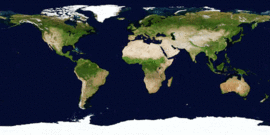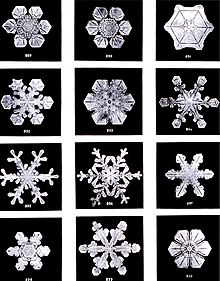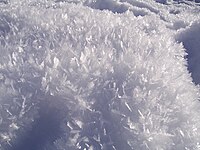| Revision as of 02:07, 11 January 2007 view source24.41.20.245 (talk)No edit summary← Previous edit | Revision as of 03:02, 11 January 2007 view source Chrislk02 (talk | contribs)29,820 editsm Reverted good faith edits by 24.41.20.245 per policy concerns. Please read up on policies and guidelines. Thanks!Next edit → | ||
| Line 15: | Line 15: | ||
| ==Benefits and problems== | ==Benefits and problems== | ||
| ] railway station.]] | ] railway station.]] | ||
| Snow is used as a thermal insulator conserving the heat of the Earth and protecting crops from sub-freezing weather. On the other hand, substantial snowfall sometimes disrupts infrastructure and services, even those of a region that is accustomed to such weather. Automotive traffic may be greatly inhibited or may be stifled entirely. Basic infrastructures such as ], telephone lines, and gas supply can also be shut down. This can lead to a "]", which is a day on which the school or other services are cancelled due to an unusually heavy snowfall |
Snow is used as a thermal insulator conserving the heat of the Earth and protecting crops from sub-freezing weather. On the other hand, substantial snowfall sometimes disrupts infrastructure and services, even those of a region that is accustomed to such weather. Automotive traffic may be greatly inhibited or may be stifled entirely. Basic infrastructures such as ], telephone lines, and gas supply can also be shut down. This can lead to a "]", which is a day on which the school or other services are cancelled due to an unusually heavy snowfall. | ||
| In areas that normally have very little or no snow, a snow day may occur with light accumulation or even the threat of snowfall, as those areas are ill-prepared to handle any amount of snow. A ], ], or ] can occur when excessive snow has accumulated on a mountain and there is a sudden change of temperature. | In areas that normally have very little or no snow, a snow day may occur with light accumulation or even the threat of snowfall, as those areas are ill-prepared to handle any amount of snow. A ], ], or ] can occur when excessive snow has accumulated on a mountain and there is a sudden change of temperature. | ||
Revision as of 03:02, 11 January 2007
For other uses, see Snow (disambiguation).

Snow is precipitation in the form of crystalline water ice, consisting of a multitude of snowflakes. Since it is composed of small ice particles it is a granular material. It has an open and therefore soft structure, unless packed by external pressure.
Occurrence

Permanent snow covering is affected by factors such as the degree of slope on the land, amount of snowfall and the force and nature of the winds. As temperature decreases with altitude, high mountains, even near the Equator, have permanent snow cover on their upper portions, around 5,300 m low. Examples include Mount Kilimanjaro in Tanzania and the Tropical Andes in South America; however, the only snow actually to appear on the Equator is at 30 ft altitude of the southern slope of Volcán Cayambe in Ecuador (Google Earth images).

Conversely, many regions of the Arctic and Antarctic receive very little precipitation and therefore experience little snowfall despite the bitter cold (cold air, unlike warm air, cannot take away much water vapor from the sea). Here, the snow does not melt at sea level. In addition to the dry, snowless regions of the poles, there are some mountains and volcanoes in Bolivia, Chile and Argentina that are high (4,500 m-6,900 m) and cold, but the lack of precipitation near the hyperarid Atacama Desert prevents snow from accumulating into glaciers.
Benefits and problems

Snow is used as a thermal insulator conserving the heat of the Earth and protecting crops from sub-freezing weather. On the other hand, substantial snowfall sometimes disrupts infrastructure and services, even those of a region that is accustomed to such weather. Automotive traffic may be greatly inhibited or may be stifled entirely. Basic infrastructures such as electricity, telephone lines, and gas supply can also be shut down. This can lead to a "snow day", which is a day on which the school or other services are cancelled due to an unusually heavy snowfall.
In areas that normally have very little or no snow, a snow day may occur with light accumulation or even the threat of snowfall, as those areas are ill-prepared to handle any amount of snow. A mudslide, flash flood, or avalanche can occur when excessive snow has accumulated on a mountain and there is a sudden change of temperature.
Snowflake
A snowflake is an aggregate of ice crystals that forms while falling in and below a cloud. They are typically hexagonally (three-fold) symmetrical however, no two snowflakes will look exactly alike.
Geometry
 |
||
 | ||
A snowflake usually has six symmetric arms (along three symmetric axes), which arise from the hexagonal crystal structure of ordinary ice along its 'basal' however, the exact shape of the snowflake is determined by the temperature at which it forms.. Rarely, at a temperature of around -2 C (28 F), snowflakes can form in three-fold symmetry - triangular snowflakes . Snowflakes are not perfectly symmetric however. The most common snowflakes are visually irregular, although near-perfect snowflakes may be more common in pictures because they are more visually appealing.
Snowflakes can come in many different forms, including columns, needles, and plates (with and without "dendrites" - the "arms" of some snowflakes). These different forms arise out of different temperatures and water saturation - among other conditions. Snowflakes form below about -10 C (14 F), solidifying around a frozen center droplet. Between temperatrues of -1 C (30 F) and -3 C (27 F), the snowflake will be in the form of a dendrite or a plate. As temperatures get colder, between -5 C and -10 C The crystals will form in either needles or hollow columns. In special circumstances, where the crystal has started forming at around -5 C, and is then exposed to warmer or colder temperatures, a capped column may be formed which consists of a column like design capped with a dendrite or plate like design on each end of the column. At even colder temperatures, the snowflake design returns to the more common dendrite and plate. At temperatures approaching -20 C, Sectored plates are formed which appears as an dendrite, which each dendrite appearing flattened, like the design of an snowflake plate.
Snow machines shoot a mixture of water and compressed air out of nozzles. The water comes out as fine droplets, and the air cools as it decompresses, causing the droplets to freeze. A fan blows the ice particles onto the slopes. Artificial snow is made of frozen water droplets, with none of the elaborate structure found in real snow crystals.
There are, broadly, two possible explanations for the symmetry of snowflakes. Firstly, there could be communication or information transfer between the arms, such that growth in each arm affects the growth in each other arm. Surface tension or phonons are among the ways that such communication could occur. The other explanation, which appears to be the prevalent view, is that the arms of a snowflake grow independently in an environment that is believed to be rapidly varying in temperature, humidity and other atmospheric conditions. This environment is believed to be relatively spatially homogeneous on the scale of a single flake, leading to the arms growing to a high level of visual similarity by responding in identical ways to identical conditions, much in the same way that unrelated trees respond to environmental changes by growing near-identical sets of tree rings. The difference in the environment in scales larger than a snowflake leads to the observed lack of correlation between the shapes of different snowflakes. The six-fold symmetry happens because of the basic hexagonal crystaline structure from which the snowflake grows. Surprisingly, the exact reason for the three-fold symmetry of triangular snowflakes is still a mystery.
There is a widely-held belief that no two snowflakes are alike, but that claim has not been proven, and, due to the astronomical number of snowflakes that fall, is impossible to prove by exhaustive methods. Strictly speaking, it is extremely unlikely for any two objects in the universe to contain an identical molecular structure; but, there are, nonetheless, no known scientific laws which prevent it. In a more pragmatic sense, it's more likely, albeit not much more, that two snowflakes are visually identical if their environments were similar enough, either because they grew very near one another, or simply by chance. The American Meteorological Society has reported that matching snow crystals were discovered by Nancy Knight of the National Center for Atmospheric Research. The crystals were not flakes in the usual sense but rather hollow hexagonal prisms.
A common estimate is that a snowflake can appear in 10 forms, under the estimate that a snowflake has 100 attributes which can vary, resulting in 100! forms. However, the number of possible snowflakes per the atomic structure would be based on the number of molecules, and the former number would be very, very large.
Electron microscope gallery

Density
The water equivalent of a snow pack is the amount of water that it contains, regardless of its depth. For example, if the snow covering a given area has a water equivalent of 5 m, then it will melt into a pool of water 5 m deep covering the same area. This is a much more useful measurement to hydrologists than snow depth, as the density of even freshly fallen snow widely varies. New snow often has a density of around 12% of water, and even under cold conditions, the same snow will settle under its own weight until it is approximately 33% water. More snow on top of this will compress it even further. By late spring, snow densities often exceed 50% of water.
Water equivalent is of great interest to water managers wishing to predict spring runoff and the water supply of cities downstream. Measurements are made manually at marked locations known as snow courses, and remotely using special scales called snow pillows.
Records
The highest seasonally cumulative precipitation of snow ever measured was on Mount Baker, Washington in the United States during the 1998–1999 season. Mount Baker received 1140 in. (29 m) of snow, thus surpassing the previous record holder, Mount Rainier, Washington which during the 1971–1972 season received 1122 in. (28.5 m) of snow.
Recreation

Some forms of recreation depend on snow
- Many winter sports, such as skiing, snowboarding, ice skating, snowmobiling and snowshoeing
- Playing with a sled or riding in a sleigh
- Building a snowman or snow fort
- Throwing snowballs mutually in a snowball fight or at others to tease them. (Humans seem to be the only species that throw their snowballs. Pygmy chimpanzees have been known to carry snowballs around, but never to throw them.)
- Making a snow angel
Where snow is scarce but the temperature is low enough, snow cannons may be used to produce an adequate amount for such sports. The world's biggest snowcastle is built in Kemi, Finland, every winter.
Types of snow


- Ice
- Densely packed material formed from snow that doesn't contain air bubbles. Depending on the snow accumulation rate, the air temperature, and the weight of the snow in the upper layers, it can take snow a few hours or a few decades to form into ice.
- Corn
- Coarse, granular wet snow. Most commonly used by skiers describing good spring snow. Corn is the result of diurnal cycle of melting and refreezing.
- Thundersnow
- A thunderstorm which produces snow as the primary form of precipitation.
- Powder
- Freshly fallen, uncompacted snow. The density and moisture content of powder snow can vary widely; snowfall in coastal regions and areas with higher humidity is usually heavier than a similar depth of snowfall in an arid or continental region. Light, dry (low moisture content) powder snow is prized by skiers and snowboarders. It is often found in the Rocky Mountains of North America.
- Firn
- Snow which has been lying for at least a year but which has not yet consolidated into glacier ice. It is granular.
- Flurries
- A period of light snow with usually little accumulation with occasional moderate snowfall.
- Sleet
- In Britain, rain mixed with snow; in America, ice pellets formed when snowflakes pass through a layer of warm air, thaw, then refreeze on further descent.
- Soft hail
- Granules of snow or ice pellets formed when supercooled water accretes on ice crystals or snowflakes.
- Freezing rain
- Rain that freezes on impact with a sufficiently cold surface. This can cover trees in a uniform layer of very clear, shiny ice, a beautiful phenomenon, though excessive accumulation can break tree limbs and utility lines, causing utility failures and possible property damage.
- Snizzle
- A mixture of snow and drizzle. This termed was coined by a meteorologist on the Boston television station WBZ-TV.
- Snow storm
- A long storm of relatively heavy snow.
- Snow squall
- A brief, very intense snowstorm.
- Blizzard
- A long-lasting snow storm with intense snowfall and usually high winds. Particularly severe storms can create whiteout conditions where visibility is reduced to less than 1 m.
- Lake effect snow
- Produced when cold winds move across long expanses of warmer lake water, picking up water vapor which freezes and is deposited on the lee shores.
- Snowdrift
- Large piles of snow which occur near walls and curbs, as the wind tends to push the snow up toward the vertical surfaces.
- Ground blizzard
- Occurs when a strong wind drives already fallen snow to create drifts and whiteouts.
- Packing snow
- Snow that is at or near the melting point, so that it can easily be packed into snowballs and hurled at other people or objects. This is perfect for snow fights and other winter fun, such as making a snowman, or a snow fort.
- Slush
- Snow which partially melts upon reaching the ground, to the point that it accumulates in puddles of partially-frozen water.
- Hail
- Many-layered ice balls, ranging from "pea" sized (0.25 in, 6 mm) to "golf ball" sized (1.75 in, 43 mm), to, in rare cases, "softball" sized or greater (>4.25 in, 108 mm).
- Hailstorm
- A storm of hail. If the hail is sufficiently large, it can cause damage to cars or even people.
- Artificial snow
- Snow can be also manufactured using snow cannons, which actually create tiny granules more like soft hail (this is sometimes called "grits" by those in the southern U.S. for its likeness to the texture of the food). In recent years, snow cannons have been produced that create more natural looking snow, but these machines are prohibitively expensive.
- Watermelon snow
- A reddish/pink colored snow that smells like watermelons, and is caused by a red colored green alga called chlamydomonas nivalis
- Penitentes
- Tall blades of snow found at high altitudes
- Graupel
- Precipitation formed when freezing fog condenses on a snowflake, forming a ball of rime ice. Also known as snow pellets.
See also
- Avalanche
- Cold wave
- Frost
- Grit bin
- Igloo
- Lake effect snow
- Snow day
- Skiing
- Sleigh
- Snow cannon
- The SnowCastle of Kemi - the largest in the world
- Snow removal
- Snow sculpture
- Snowball
- Snowboard
- Snowman
- Snowshoe
- Snow blindness
- List of countries receiving snowfall
- Eskimo words for snow
Media
| Snowing |
|---|
References
- ^ Template:Harvard reference
- http://cdec.water.ca.gov/snow/misc/density.html
- http://www.usatoday.com/weather/news/1999/wsnorcrd.htm
- http://www.nps.gov/archive/mora/interp/faq.htm
External links
- Ultra-high resolution images of snowflakes.
- Snow at above freezing temperatures
- Kenneth G. Libbrecht - Snowflake FAQ




